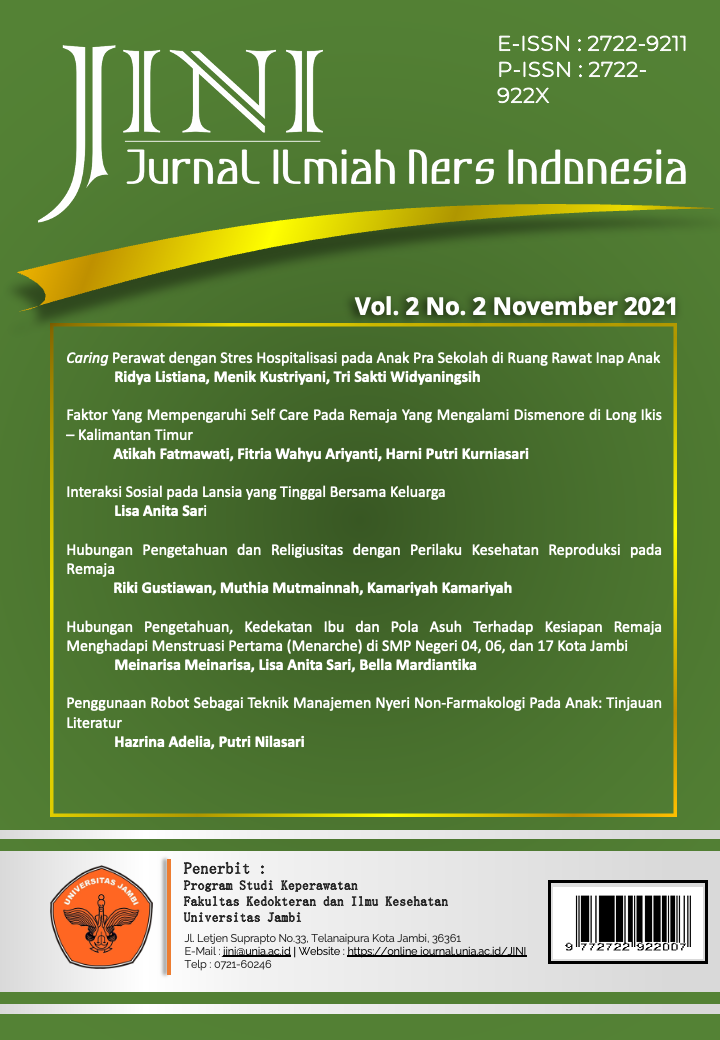Penggunaan Robot Sebagai Teknik Manajemen Nyeri Non-Farmakologi Pada Anak: Tinjauan Literatur
DOI:
https://doi.org/10.22437/jini.v2i2.15455Keywords:
Robot, pain management, pain, childrenAbstract
Pain is an unpleasant experience experienced by children during medical procedures since the beginning of life. The experience of pain that is not managed properly could be a traumatized experience for the children. The use of technology in non-pharmacological pain management strategies is able to demonstrate effectiveness and safety in its use. One of the technological models that can be used is a robot. This research is a literature study, with five online database sources (2017-2021) with the keywords, robot, pain, children, and pain management. The search and analysis obtained 9 journals that show the various uses of robots in pediatric pain management. The robots can be an alternative in non-pharmacological pain management techniques that are quite effective. The use of robots in non-pharmacological pain management in children, could reduce pain and unpleasant experiences by children during medical procedures.
Abstrak
Nyeri adalah pengalaman tidak menyenangkan yang dialami anak dalam menjalani tindakan medis sejak awal kehidupan. Pengalaman nyeri yang tidak dimanajemen dengan baik dapat membawa trauma pada anak. Penggunaan teknologi dalam strategi manajemen nyeri non-farmakologis dianggap mampu menunjukkan efektivitas dan keamanan dalam penggunaannya, dimana salah satu model teknologi yang dapat digunakan adalah, robot. Penelitian ini adalah studi literatur, dengan lima sumber database online (2017-2021) dengan kata kunci, robot, pain, children, and pain management. penelusuran dan Analisa, didapatkan 9 jurnal yang menunjukkan berbagai penggunaan robot dalam manajemen nyeri anak. Pemanfaatan robot dapat menjadi salah satu alternatif dalam teknik manajemen nyeri non-farmakologis yang cukup efektif. Dengan adanya penggunaan robot dalam manajemen nyeri non-farmakologi anak, dapat membantu anak untuk mengurangi nyeri dan pengalaman tidak menyenangkan selama tindakan medis.
Kata Kunci: robot, manajemen nyeri, nyeri, anak
Downloads
References
Ali, S., Ma, K., Dow, N., Vandermeer, B., Scott, S., Beran, T., Issawi, A., Curtis, S., Jou, H., Graham, T. A. D., Sigismund, L., & Hartling, L. (2021). A randomized trial of iPad distraction to reduce children’s pain and distress during intravenous cannulation in the paediatric emergency department. Paediatrics and Child Health (Canada), 26(5), 287–293. https://doi.org/10.1093/pch/pxaa089
Ali, S., Manaloor, R., Ma, K., Sivakumar, M., Beran, T., Scott, S. D., Vandermeer, B., Beirnes, N., Graham, T. A. D., Curtis, S., Jou, H., & Hartling, L. (2021). A randomized trial of robot-based distraction to reduce children’s distress and pain during intravenous insertion in the emergency department. Canadian Journal of Emergency Medicine, 23(1), 85–93. https://doi.org/10.1007/s43678-020-00023-5
Birnie, K. A., Noel, M., Chambers, C. T., Usman, L. S., & Parker, J. A. (2018). Psychological Interventions for Needle-Related Procedural Pain and Distress in Children and Adolescents: Summary of a Cochrane Review. Explore, 15(1), 74–75. https://doi.org/10.1016/j.explore.2018.10.014
Farrier, C. E., Pearson, J. D. R., & Beran, T. N. (2020). Children’s Fear and Pain During Medical Procedures: A Quality Improvement Study With a Humanoid Robot. The Canadian Journal of Nursing Research = Revue Canadienne de Recherche En Sciences Infirmieres, 52(4), 328–334. https://doi.org/10.1177/0844562119862742
Gates, M., Hartling, L., Shulhan-Kilroy, J., MacGregor, T., Guitard, S., Wingert, A., Featherstone, R., Vandermeer, B., Poonai, N., Kircher, J., Perry, S., Graham, T. A. D., Scott, S. D., & Ali, S. (2020). Digital technology distraction for acute pain in children: A Meta-analysis. Pediatrics, 145(2). https://doi.org/10.1542/peds.2019-1139
Jibb, L. A., Birnie, K. A., Nathan, P. C., Beran, T. N., Hum, V., Victor, J. C., & Stinson, J. N. (2018). Using the MEDiPORT humanoid robot to reduce procedural pain and distress in children with cancer: A pilot randomized controlled trial. Pediatric Blood and Cancer, 65(9). https://doi.org/10.1002/pbc.27242
Lee, R. (2019). Efficacy of a Preparation Intervention for the Management of Children ’ s Pain and Fear during Needle Procedures: Help from a Robot Named MEDi submitted to the Faculty of Graduates Studies in Partial Fulfillment of the Requirement for the Degree of MA.
Logan, D. E., Breazeal, C., Goodwin, M. S., Jeong, S., O’Connell, B., Smith-Freedman, D., Heathers, J., & Weinstock, P. (2019). Social robots for hospitalized children. Pediatrics, 144(1). https://doi.org/10.1542/peds.2018-1511
Rossi, S., Larafa, M., & Ruocco, M. (2020). Emotional and Behavioural Distraction by a Social Robot for Children Anxiety Reduction During Vaccination. International Journal of Social Robotics, 12(3), 765–777. https://doi.org/10.1007/s12369-019-00616-w
Smakman, M. H. J., Smit, K., Buser, L., Monshouwer, T., van Putten, N., Trip, T., Schoof, C., Preciado, D. F., Konijn, E. A., van der Roest, E. M., & Tiel Groenestege, W. M. (2021). Mitigating children’s pain and anxiety during blood draw using social robots. Electronics (Switzerland), 10(10), 1–16. https://doi.org/10.3390/electronics10101211
Trost, M. J., Chrysilla, G., Gold, J. I., & Mataric, M. (2020). Socially-Assistive Robots Using Empathy to Reduce Pain and Distress during Peripheral IV Placement in Children. Pain Research and Management, 2020. https://doi.org/10.1155/2020/7935215
Trottier, E. D., Doré-Bergeron, M. J., Chauvin-Kimoff, L., Baerg, K., & Ali, S. (2019). Managing pain and distress in children undergoing brief diagnostic and therapeutic procedures. Paediatrics and Child Health (Canada), 24(8), 509–521. https://doi.org/10.1093/pch/pxz026
Williams, N., MacLean, K., Guan, L., Collet, J. P., & Holsti, L. (2019). Pilot Testing a Robot for Reducing Pain in Hospitalized Preterm Infants. OTJR Occupation, Participation and Health, 39(2), 108–115. https://doi.org/10.1177/1539449218825436
Downloads
Published
How to Cite
Issue
Section
License
Copyright (c) 2021 Jurnal Ilmiah Ners Indonesia

This work is licensed under a Creative Commons Attribution-NonCommercial-ShareAlike 4.0 International License.
Jurnal Ilmiah Ners Indonesia (JINI) memberikan akses terbuka terhadap siapapun agar informasi dan temuan pada artikel tersebut bermanfaat bagi semua orang. Semua konten artikel Jurnal ini dapat diakses dan diunduh secara gratis, tanpa dipungut biaya, sesuai dengan lisensi creative commons yang digunakan.

Ciptaan disebarluaskan di bawah Lisensi Creative Commons Atribusi-BerbagiSerupa 4.0 Internasional.



